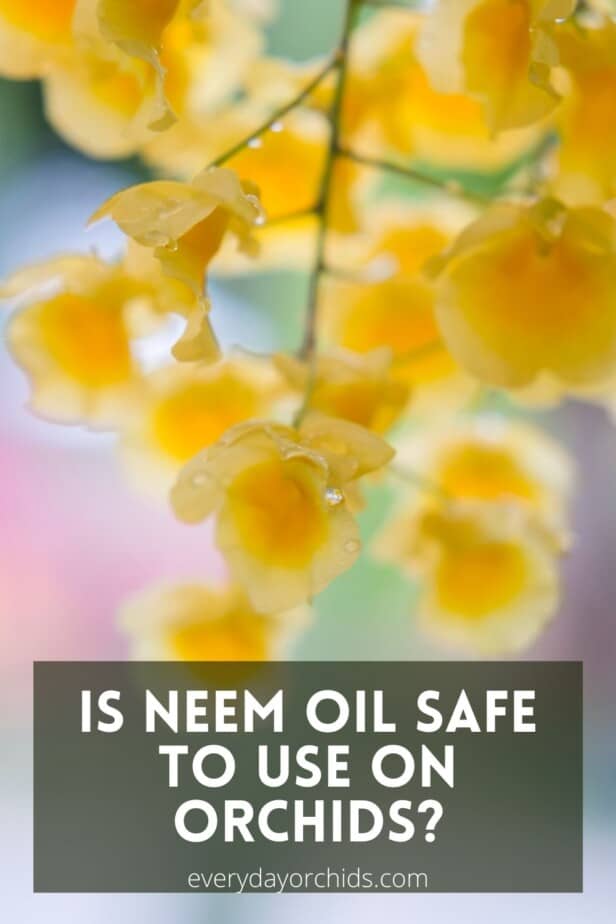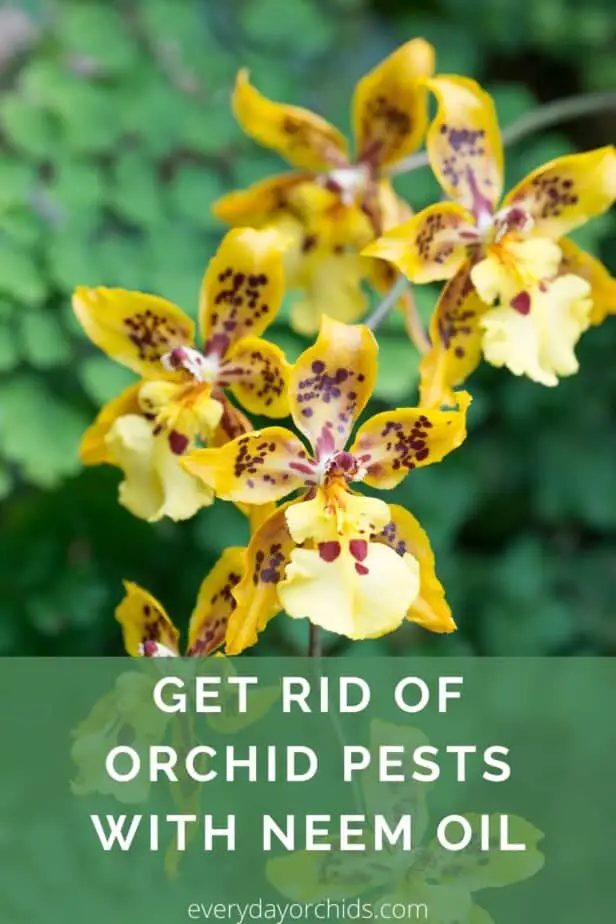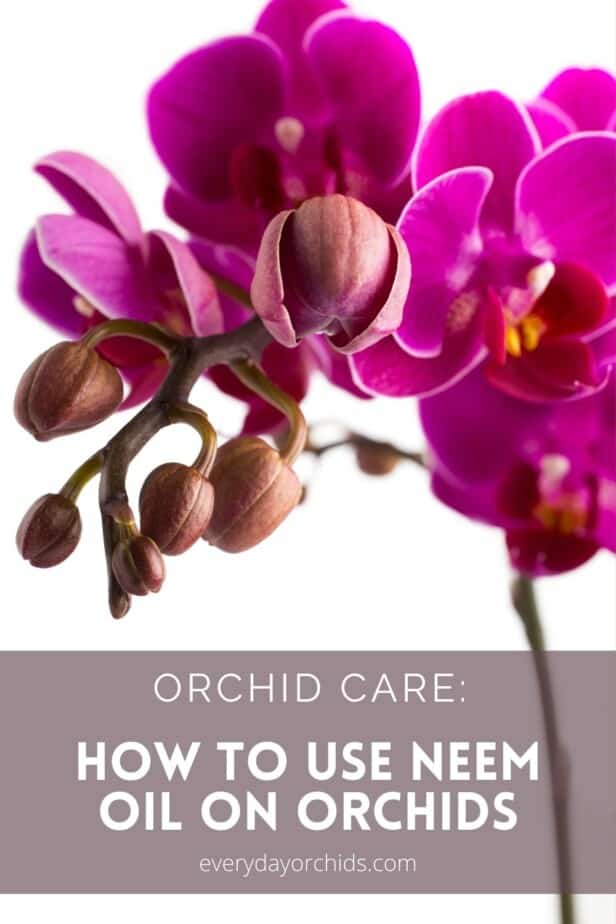Neem oil is commonly suggested as a pest control measure for plants. But you may be wondering, is neem oil safe for use on your orchid? How does it work? How do you even apply it? I will answer those questions and more below.
Neem oil is a natural pest deterrent and insecticide. It can be safely used on orchids and many other plants. You can use it as a foliar spray on your orchids to deal with aphids, spider mites, scale, and many other common orchid pests. If you are using 100% pure neem oil, you will need to mix it with a little dish soap and some water before using. For widespread pest infestations, you will likely need to do more than one application in order to get the pests under control.

Are you curious how you can use neem oil to get rid of pests on your orchid? You’ve come to the right place. Keep reading to learn more!
Please note that these links are affiliate links and as an Amazon Associate, I earn from qualifying purchases. Purchases made through affiliate links in this post may generate commissions at no additional cost to you. Use this link for a discounted Amazon Prime trial. Thank you for your support!
Table of Contents
What Is Neem Oil?

Neem oil is extracted from the seeds of the Margosa, or Neem, tree. This is a fast-growing evergreen that is commonly found in India. It is also found in many other Asian and East Asian countries.
Neem oil has been used for medicinal and insecticidal purposes for many centuries. Among other things, it has been shown to repel mosquitos, flies, treat lice and scabies, and deter a variety of insects from plants. Neem oil is even used as an ingredient in pet shampoos to treat and repel fleas and ticks.
Is Neem Oil Safe?
Yes, neem oil is safe to use on plants, including orchids. It is safe for humans, children and pets as well. Neem oil has been approved by the US Environmental Protection Agency as safe and acceptable to use on food crops.
Therefore, you can rest assured that neem oil is safe to use in your home. You can apply this oil to your houseplants without worry of accidentally poisoning your pets or exposing your family to toxic chemicals.
Types of Neem Oil
There are actually three types of neem oil that you can buy.
First, there is 100% cold-pressed neem oil. This neem oil is undiluted and unmodified. You can store it in your refrigerator (more on that below). You will need to dilute it before use. This is the most potent form of neem oil. Some forms include azadirachtin.
Second, you can buy raw neem oil. This version of neem oil also contains azadirachtin. When insects ingest or come into contact with azadirachtin, it will block insect reproduction. Azadirachtin will also stop nymphs and larvae from progressing into adulthood. Raw neem can cause burns on the foliage, so you should avoid using this one on your orchids unless it is well diluted.
Third, neem cakes are sold to target pests in the soil. This is more suitable for gardening and not the right one for your orchid plants.
Where Can You Buy Neem Oil?
You can find neem oil at most home and garden centers and hardware stores. Here are some highly-rated neem oil products available online:
- Bonide Ready-to-Use Neem Oil, 32 fl oz. This neem oil is already diluted, comes in a spray bottle and can be immediately used on your orchids.
- Bonide Ready-to-Use Neem Oil, 128 fl oz. This is the same product as above, but comes in a larger container. Useful if you have a lot of plants to cover or a large infestation to deal with. This gallon jug of diluted neem oil has a spray nozzle that comes with it.
- Organic Neem Bliss 100% Cold-Pressed Neem Oil, 16 oz. Unlike the above two products, this 100% cold-pressed neem oil has a high azadirachtin content. Remember, azadirachtin is the active ingredient to block insect reproduction and development into the adult stage. It is more effective at pest control for this reason. You will need to dilute the cold-pressed neem oil before use. Make sure you also have dish soap and spray bottles handy to prepare the solution.
- Organic 100% Cold-Pressed Neem Oil by Kate Blanc., 4 oz. This is a smaller bottle of 100% cold-pressed neem oil, handy to have on hand for minor pest infestations or regular preventative pest control measures.
Be aware that Bonide neem oil products do not appear to carry azadirachtin. It is not listed among the ingredients list. If you want a product with azadirachtin, then you would be better off buying a cold-pressed neem oil. Most likely, the effectiveness from the Bonide products is related to how the oil smothers and suffocates the insects.
Which Orchid Pests Does Neem Oil Target?
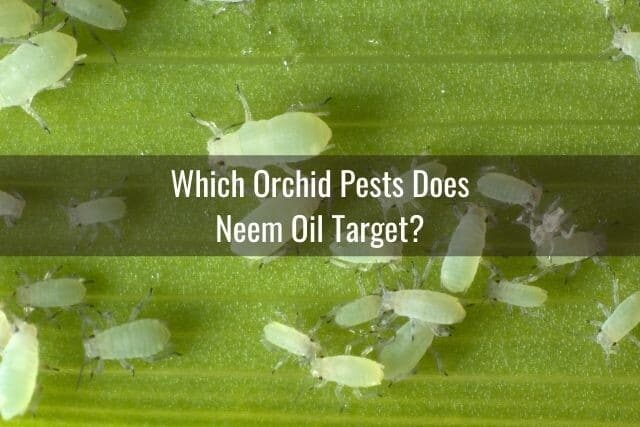
Neem oil with azadirachtin works by repelling adult insects and disrupting the egg and larval stages of insect development. It deters feeding and growth of the insects present. It stops reproduction. Over time, you will see less and less pests on your orchid plant.
The neem oil also works by smothering and suffocating the adult pests so they can’t breathe. It prevents them from easily moving between plants.
Neem oil is effective against spider mites, aphids, thrips, scale, and mealybugs. Your mileage may vary but some orchid growers have found neem oil to be more effective against pests such as scale and spider mites and less effective against others. While it may not completely eradicate mealybugs or aphids, it can be used to greatly reduce the overall pest population.
How Do You Apply Neem Oil to Orchids?
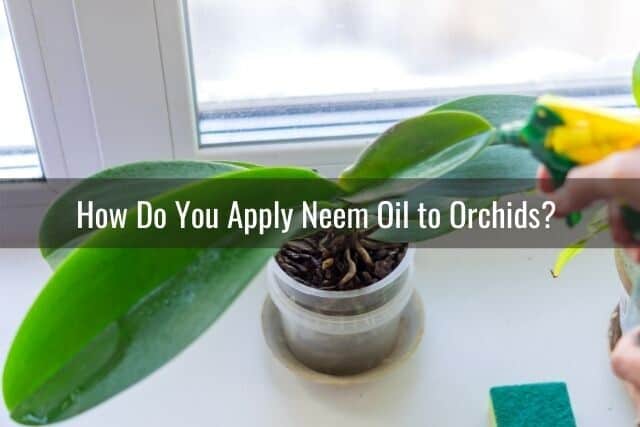
To use neem oil on your orchid plants, you will first need to prepare a spray solution of neem oil. If you buy 100% neem oil, you will first need to dilute it with water before using it on your plants.
- Mix 1 teaspoon (5ml) of cold-pressed or raw neem oil with 1/2 teaspoon (2.5ml) dish soap in 1 quart of warm water. Shake well.
- Pour this into a spray bottle.
- Set your spray bottle on the “fine mist” setting.
- Spray the diluted neem oil solution generously onto all affected areas of your orchid, including the underside of the leaves.
- Be sure to shake the bottle intermittently in order to keep all ingredients mixed and well-distributed.
- In addition to spraying the orchid itself, also spray the potting media to get any eggs or larva hiding in there.
Key Points to Remember When Using Neem Oil
Apply this solution in the early morning or at dusk. Avoid applying neem oil to orchids in direct sunlight. Doing so can cause burning of the orchid leaves.
If you choose to apply neem oil in the morning, do it after you finish watering your orchids. Watering after applying the neem oil could wash off the solution and decrease its effectiveness.
Alternatively, you could also apply this solution in the late afternoon, near dusk. This will allow you to avoid the intense afternoon light and prevent you from accidentally burning the orchid leaves.
When applying the neem oil to your orchids, avoid doing so in hot weather or if temperatures are over 85 degrees Fahrenheit. Not only does neem oil become less potent at high temperatures, but you also run the risk of damaging your orchid leaves by applying neem oil in hot weather.
Do not use oils on plants that are stressed by disease, high heat or drought.
How Often Should You Apply Neem Oil To Your Orchids?
You will want to apply neem oil to your orchids every few days, for as long as there is a pest infestation. Make sure you make a fresh batch of neem oil solution each time, following the steps outlined above.
The mixed neem oil solution will only last for 4 to 8 hours before it starts to break down and become less effective.
For this reason, it is best to make a new batch of solution each time. Unless you are going to spray down a large number of plants, it is better and more cost-effective to make a small batch each time you need it.
Also, be sure you use dish soap in the solution. Don’t skip this step! The dish soap works as an emulsifier. It helps break down and evenly disperse the oil in the water. In addition, the soap helps break down the waxy coating of hard-shelled insects such as scale, making the neem oil more effective.
Use a gentle dish soap such as Ivory or a castile soap. Avoid using Dawn dish soap. Repeated uses with Dawn dish soap can damage the waxy coating on the orchid leaves.
If you prefer not to go through the hassle of diluting and mixing, you can buy ready-to-use neem oil. This version has already been diluted down. Bonide Neem oil comes ready-to-use, either in gallon jugs that you can pour into your own spray bottles, or 32 ounce spray bottles ready to go.
Storage
Heat can degrade this oil, so proper storage is important.
Store your neem oil in a cool, dry location.
Some people store this oil in the refrigerator to help it last longer and keep it from becoming rancid.
If you do store it in the refrigerator, you may find that this oil solidifies in cold temperatures, much like coconut oil. This will not reduce its effectiveness in any way. You will just need to bring it up to room temperature before use.
To bring it to room temperature quickly, place the container of solid neem oil in a bucket of very warm water.
Some people store the neem oil in smaller containers in the fridge, so they only need to warm up a small amount at a time. This would be a smart idea if you happen to buy a gallon container of 100% neem oil and only need a little at a time.
Benefits Of Using Neem Oil On Orchids
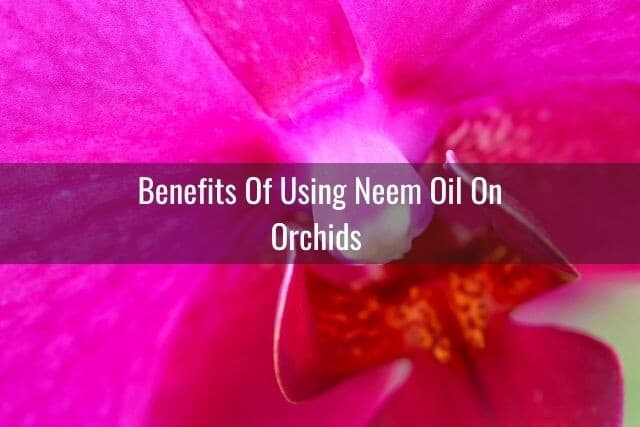
There are several benefits to using neem oil on your orchids to combat common orchid pests.
A huge benefit is that this product is natural and organic. It provides a level of insect control that is impressive for an oil that is derived from a seed.
Neem oil is non-toxic and safe for humans, pets and beneficial insects. It can be safely used indoors or outdoors.
In addition, neem oil is biodegradable and does not build up chemical resistance in pests.
It also has anti-fungal properties. It does this by preventing the germination of fungal spores on the plant. This is incredibly helpful, because sometimes, an insect infestation can also lead to a fungal infection in your orchid.
Neem oil can be used to deter insects from coming to your plant in the first place. If you choose to use neem oil for prophylactic purposes, you can spray your orchid plant and potting media once a month or so with a diluted neem oil solution.
Neem oil can also be used to clean and shine your orchid’s leaves. Place a small amount of diluted neem oil on a soft cloth. Use this to gently wipe down the surface of your orchid’s leaves. It will add a nice shine to the leaves, while also cleaning and providing an extra layer of protection against pests and fungal infections.
Drawbacks of Using Neem Oil On Orchids

One drawback of neem oil is the smell. People complain that it smells strongly of garlic or onions. This smell is most noticeable when it is being applied, but goes away once the oil dries. To counteract this, I would suggest using this in a well-ventilated area, opening a window, or turning on a fan for a short period of time.
Another drawback to using neem oil on your orchids and other plants is that it doesn’t work that fast. Bugs won’t drop dead on contact. In fact, it may take a few days before you notice a difference in the numbers of pests crawling around.
Neem oil will not completely eliminate pests in the first application, or even the second or third application if you have a lot of pests. What it does is reduce the pest population to a more manageable level. You will likely need repeated applications of neem oil on a regular basis to get rid of them all.
Since neem oil may not completely remove pests on its own, you might need to use this in combination with other pest control methods. Most likely, you will need to also manually remove the insect pests with a cotton swab. Regularly inspect your orchid plants and pots to gauge effectiveness of the neem oil spray.
While neem oil is relatively safe and non-toxic, it can harm bees if they come into contact with neem oil spray. Be careful when applying this outdoors. Once the neem oil settles, it will not hurt the bees. However, if you are spraying and a bee flying by gets sprayed, well, they can be negatively affected.
Also, azadirachtin, an ingredient in neem oil, is mildly toxic to fish and other types of aquatic animals. Keep this in mind if you are spraying your orchids near an aquarium or outdoor pond with koi fish.
One last drawback of using neem oil is the fact that this is an oil. Some people prefer not to use oils on their plants, for fear that the oils will clog the pores, or stomata, of the leaves.
Use Caution When Using Neem Oil On These Orchids
Certain orchid species, such as Miltonia and Masdevallia orchids, are more sensitive to neem oil. Their flowers can be adversely affected by neem oil use. When spraying, avoid getting neem oil on the flowers or buds.
Some orchid growers have reported that Dendrobium leaves turn yellow after being sprayed with neem oil. However, not all Dendrobium growers have experienced this.
Just in case, in order to prevent this from possibly happening, avoid spraying neem oil on the orchid under direct sunlight. In addition, make sure you dilute pure neem oil with dish soap and water. Most importantly, before spraying the whole plant, do a “test” spray on a small area first.
In addition, avoid using neem oil on outdoor orchids during the height of the day. The combination of neem oil and direct sunlight would cause burning and damage to the orchid leaves.
If the orchids are in the shade or partial shade, than those orchids would be fine to use neem oil on. Otherwise, just wait until early morning or dusk to apply the neem oil solution.
Final Thoughts
Neem oil is a great, non-toxic insecticide you can safely use on your orchids. When purchasing neem oil, be sure you choose the right one.
The 100% cold-pressed neem oil is preferred and has higher effectiveness, mainly because of the presence of azadirachtin. If you buy cold-pressed neem oil, you will need to dilute it with dish soap and water first. However, if you rather not go through the dilution and preparation process, purchasing ready-to-use Bonide neem oil would be a perfectly acceptable alternative.
Please follow the application do’s and don’ts listed above in order to ensure your orchid has the best outcome. Repeated applications of neem oil may be necessary to completely eradicate an orchid pest infestation. It will take some time to get rid of all the bugs, so be patient.
Hope this helps! As always, happy orchid growing, and thank you for reading!
If you enjoyed this article, please pin it and share!

